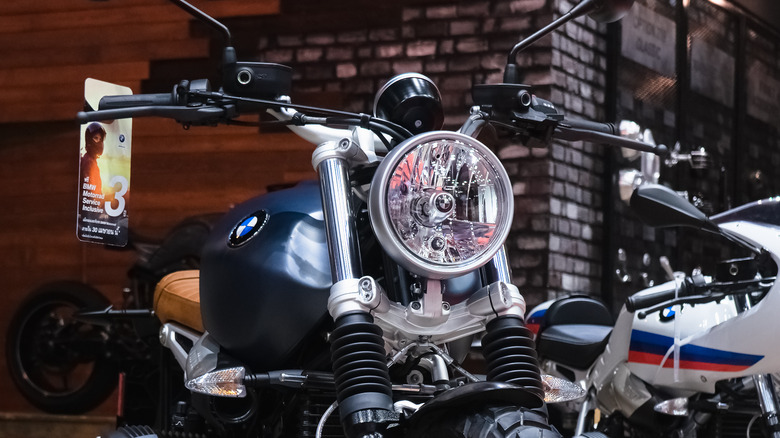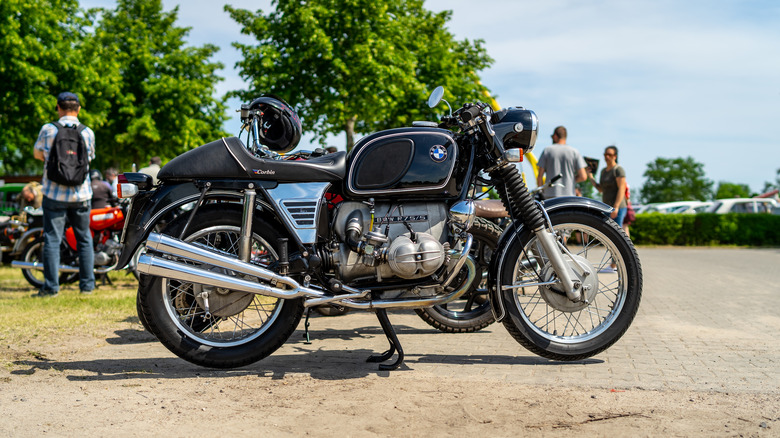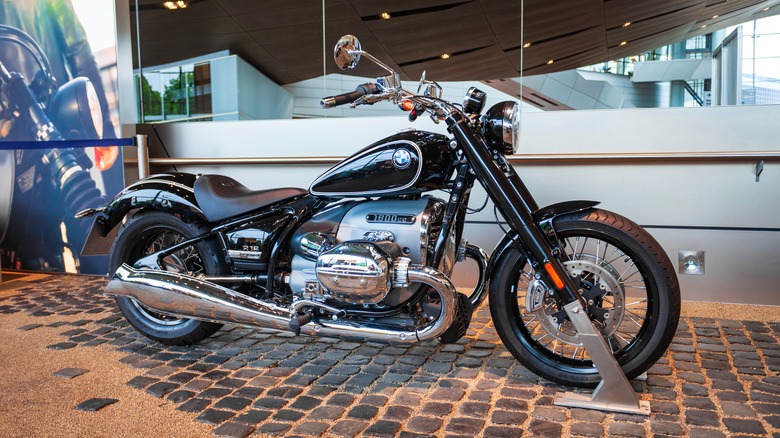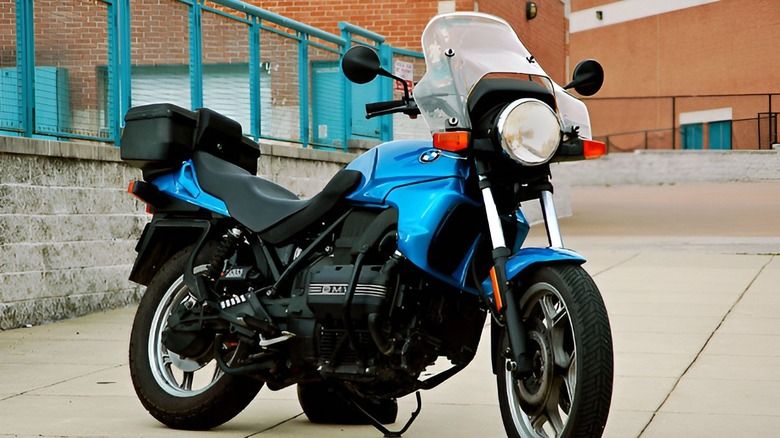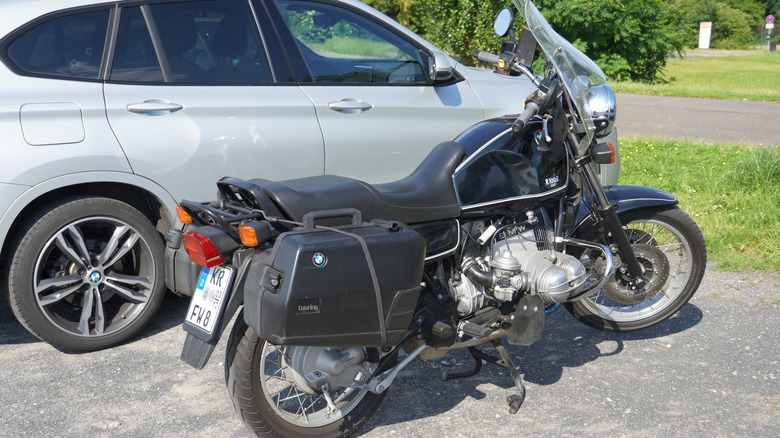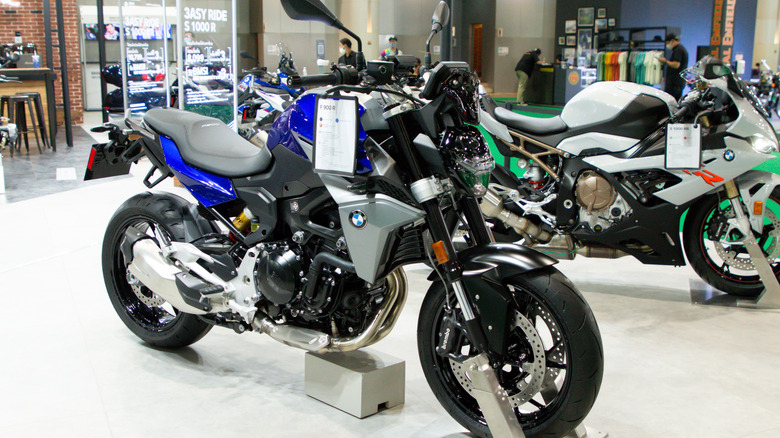5 Of The Most Underrated BMW Motorcycles Ever Made
When most people think of a BMW, they likely think of the iconic kidney grills and nonfunctional turn signals, but to be true to the brand's history, you would have to think of something smaller, lighter, and two fewer wheels: the products of BMW Motorrad, the German automaker's motorcycle arm.
BMW started out as an airplane engine manufacturer but had to pivot following the Treaty of Versailles, which, amongst other things, banned the manufacture of German aircraft and aircraft engines. This pivot resulted in the creation of the iconic flat twin or boxer engine for which BMW is known, and the R 37 it was mounted to, in 1923 (the company would get into manufacturing cars 5 years later) and the rest is history.
Since then, BMW has created a series of iconic motorcycles, and if we were to create a list of the best-regarded examples, we would have to include far too many: the endlessly-customizable BMW R nine T, the go-everywhere R1200GS, the gorgeous and supremely speedy S1000RR, the less-attractive but aerodynamic K1, and at least a dozen more. Instead, we're going to take a look at five of the slightly less popular yet still compelling motorcycles they have put out over the years.
R75/5
Released in 1970, the R75/5 is the most powerful version of BMW's /5 series of motorcycles by virtue of its 750 cc boxer engine. It stood out from bikes that preceded it on multiple fronts. For instance, the /5 series introduced the air-cooled Type 247 Boxer Twin engine, which BMW continued to use over the next three decades, until 1995. It was also the first BMW bike to come with an electric starter, though because it came out in the '70s, the startup process wasn't quite as simple as pushing a button.
The combination of these features means the R75/5 is easily capable of accomplishing all that a modern bike will, just with fewer bells and whistles. It will easily cruise down a highway, tops out at 109 mph while achieving good gas mileage, and has two versions with different handling characteristics — R75/5s made from January 1973 onward had a slightly longer wheelbase for greater stability. It also came with its own fair share of 1970s BMW design decisions. For example, once you locate the key's home on top of the headlight, you would then find that it also doubled as the headlight switch.
Used examples generally start around $5,000 and can even go as high as $15,000, though you will find plenty of good options at the lower end of the price range. That being said, prices have been rising overall, so you might want to make a decision sooner, rather than later.
R18
BMW's first full-fat cruiser is quite the departure from the other motorcycles in this list, which are comparatively small, lightweight, and agile, but then that's what you expect from a cruiser — a large, comfortable boat that will insulate you from the vast number of miles you're covering.
However, the R18 beats expectations in the cruiser sector for a host of reasons, starting with the engine: BMW's largest ever boxer, which comes in at a whopping 1,802 cc and generates 91 horsepower and 116 foot-pounds of torque. The engine alone can be enough of a reason to buy the motorcycle but the dynamics are far better than many would come to expect, especially on winding roads. On top of the dynamics, an impressive suite of driver aides, such as adaptive cruise control, makes the ride even more stress-free.
Two reasons why the R18 may not receive quite as much attention as it deserves may be: it competes with stalwarts in the cruiser space like Harley-Davidson, and it deviates from what most people would envision when they think of a BMW motorbike. At first glance, both of these factors play against the R18, but only on paper. In practice, it easily holds its own against the competition.
While the MSRP of the base R18 is around $15,000, model variants and options can easily take it above $30,000. Meanwhile, used examples can go for anywhere between $10,000 and $20,000 depending on age, mileage, and trim level.
K75
The BMW K75 was a straight-three-cylinder, 75hp standard motorcycle available in the U.S. from 1990 to 1995. Developed alongside the larger and more powerful K100 but released later, the K75 was designed to be a more direct competitor to the motorcycles coming out of Japan at the time by being lighter, smoother, and more nimble than its sibling. This was primarily accomplished by removing one cylinder from the "Flying Brick" engine, named such for its rectangular shape, and adding a balance shaft to counter the vibration of the three cylinders.
As far as the price is concerned, it might just be a case similar to that of the (in)famous third-pound burger, or it may just be self-fulfilling hype (or lack thereof) that markets sometimes create on their own. Still, good used K75s can currently be found for anywhere between $2000 and $4000, while the K100 can trend closer to $5000, or even higher.
While the market seems to value the K100 more than the K75, the more you get to know the two bikes, the harder it is to see why, aside from a few specific areas: power and size — the K100 is better endowed on both fronts, though you are left with worse agility, heat, and vibration. Besides, there's only so much power you need for your day-to-day riding, and if you want more space to carry people, you can easily buy a car from the same era for a similar price.
[Featured image by Louie Armstrong via Wikimedia Commons | Cropped and scaled | CC BY-SA 2.5]
R100R
Building on the enthusiasm generated with the release of the modern K100 and K75 in the '80s, BMW's first retro-inspired motorcycle was released in 1991. Similar to the modern-day F900R, the R100R was a roadster version of a contemporary dual-purpose adventure motorcycle, the R100GS, but paid homage to BMW bikes from previous generations.
As a roadster, the R100R was designed to have strong ergonomics and comfortable ride quality, allowing the rider to stay in their seat for hours, thus covering over 200 miles on a single tank of gas. It also carried the repair equipment of the day, which was stored under the removable seat. As a retro-inspired motorcycle, the R100R bore such styling cues as wire-spoke wheels, two possible paint colors — Classic Black and Purple Haze — a chromed headlight shell, and valve covers reminiscent of the rare R68, which, at the time of its unveiling in 1951, was touted as the first 100 mph motorcycle. It also broke from the newly-established straight-cylinder engine layout to return to a horizontally opposed, or boxer, twin layout, as BMW was well known for using boxer engines prior to the debut of the K100 and K75 in the previous decade.
R100Rs can now be found online anywhere between $5000 and $12000, depending on how well a bike in question has aged, or how rare it is.
F900R
The roadster version of the F900XR adventure sports bike, the F900R utilizes the same engine and general setup in order to create a bike that stands out a little less and is clearly more of a roadster, while still delivering impressive performance and features, especially for its relatively entry-level positioning within the BMW range. The biggest issue the F900R faces is that its counterpart, the XR, has proven to be an exceedingly capable and thus well-received bike, for a slightly higher price.
That being said, the F900R isn't as far off as some may think and is actually the sportier of the two bikes, weighing less and featuring a lower profile for both the vehicle and the rider. Despite its positioning as a bike for people new to the higher end of the motorcycling spectrum as well as intermediates, it has sufficient power and speed for most riders — in fact, it even has its own race series – and comes with a healthy selection of driver aids and features, such as two basic driving modes, adaptive cornering lights that turn on in turns to provide better visibility, stability control, ABS, and a screen instead of traditional gauges. This being a machine from the same brand that brought the world heated seat subscriptions, more features, such as additional drive modes, gear shift assist capabilities, and beyond are locked behind upgrade packages. However, the base bike, which starts at just under $9000, is more than capable in its basic configuration.
